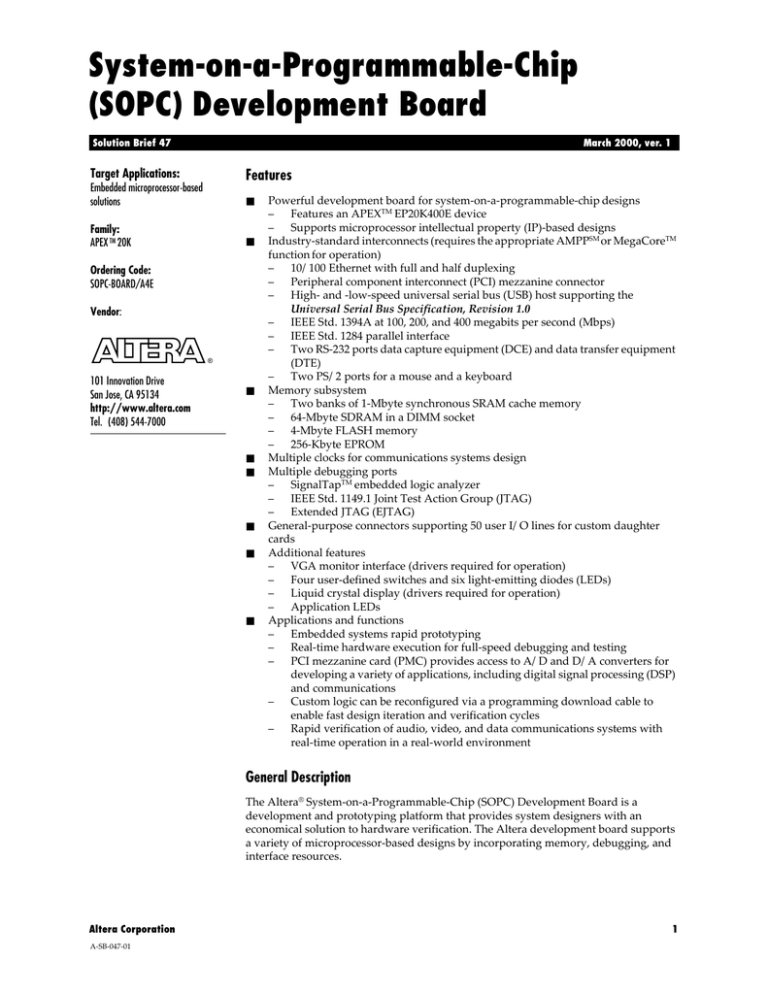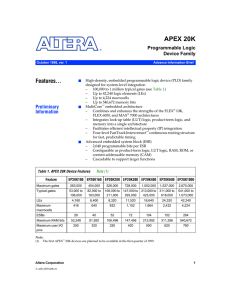
System-on-a-Programmable-Chip
(SOPC) Development Board
Solution Brief 47
March 2000, ver. 1
Target Applications:
Features
Embedded microprocessor-based
solutions
■
Family:
APEX TM 20K
■
Ordering Code:
SOPC-BOARD/A4E
Vendor:
®
101 Innovation Drive
San Jose, CA 95134
http://www.altera.com
Tel. (408) 544-7000
■
■
■
■
■
■
Powerful development board for system-on-a-programmable-chip designs
–
Features an APEXTM EP20K400E device
–
Supports microprocessor intellectual property (IP)-based designs
Industry-standard interconnects (requires the appropriate AMPPSM or MegaCoreTM
function for operation)
–
10/100 Ethernet with full and half duplexing
–
Peripheral component interconnect (PCI) mezzanine connector
–
High- and -low-speed universal serial bus (USB) host supporting the
Universal Serial Bus Specification, Revision 1.0
–
IEEE Std. 1394A at 100, 200, and 400 megabits per second (Mbps)
–
IEEE Std. 1284 parallel interface
–
Two RS-232 ports data capture equipment (DCE) and data transfer equipment
(DTE)
–
Two PS/2 ports for a mouse and a keyboard
Memory subsystem
–
Two banks of 1-Mbyte synchronous SRAM cache memory
–
64-Mbyte SDRAM in a DIMM socket
–
4-Mbyte FLASH memory
–
256-Kbyte EPROM
Multiple clocks for communications systems design
Multiple debugging ports
–
SignalTapTM embedded logic analyzer
–
IEEE Std. 1149.1 Joint Test Action Group (JTAG)
–
Extended JTAG (EJTAG)
General-purpose connectors supporting 50 user I/O lines for custom daughter
cards
Additional features
–
VGA monitor interface (drivers required for operation)
–
Four user-defined switches and six light-emitting diodes (LEDs)
–
Liquid crystal display (drivers required for operation)
–
Application LEDs
Applications and functions
–
Embedded systems rapid prototyping
–
Real-time hardware execution for full-speed debugging and testing
–
PCI mezzanine card (PMC) provides access to A/D and D/A converters for
developing a variety of applications, including digital signal processing (DSP)
and communications
–
Custom logic can be reconfigured via a programming download cable to
enable fast design iteration and verification cycles
–
Rapid verification of audio, video, and data communications systems with
real-time operation in a real-world environment
General Description
The Altera® System-on-a-Programmable-Chip (SOPC) Development Board is a
development and prototyping platform that provides system designers with an
economical solution to hardware verification. The Altera development board supports
a variety of microprocessor-based designs by incorporating memory, debugging, and
interface resources.
Altera Corporation
A-SB-047-01
1
SB 47: System-on-a-Programmable-Chip (SOPC) Development Board
The SOPC board is primarily designed for implementing microprocessor functions and
other standard IP functions in the on-board APEX device. The board includes interfaces
for widely used standard interconnects. To use interconnect functions on the board,
you must implement control logic into the APEX device.
The development board also supports EJTAG, which develops and debugs MIPS-like
microprocessor functions, and JTAG for other system testing. For additional analysis,
the JTAG port can be used with the SignalTap embedded logic analyzer, available with
the Altera QuartusTM development software. Figure 1 shows a picture of the
development board.
Figure 1. System-on-a-Programmable-Chip Development Board
APEX EP20K400E-1 Device
The EP20K400E-1 device featured on the development board has 16,640 logic cells,
212,992 RAM bits, and 423,000 ASIC-equivalent gates in a 652-pin ball-grid array (BGA)
package.
Power
The eight-layer bench-top board features four signal layers, a full 3.3-V power plane,
and a split 2.5-V/5.0-V power plane. The APEX device’s core power is driven at 2.5 V,
and the IEEE Std. 1394A physical layer is driven at 3.3 V. An external 5.0-V power
supply is required to power the board; the 5.0-V power supply regulates the 3.3-V and
2.5-V power supplies.
2
Altera Corporation
SB 47: System-on-a-Programmable-Chip (SOPC) Development Board
Clocks
The development board features ten unique clocks; the user can select up to six. The
board also has two barrel nut connectors (BNC) to support communications systems
design. The APEX global clock input can be driven by a 66-MHz oscillator or by an
external clock via a BNC connector. The second global clock signal is connected to an
oscillator that can drive an IP function at either 33 MHz or 66 MHz.
Memory
To support processor functions within the APEX device, the board includes a memory
system of the following parts:
■
■
■
Volatile memory: 64 Mbytes of synchronous DRAM, organized as 8 Mbytes × 64
Non-volatile memory: 4 Mbytes of FLASH memory and a 256-Kbyte EPROM
Pipelined cache memory with burst SRAM organized as 256 Kbytes × 32
Benefits
The SOPC board offers the user a variety of hardware and software benefits.
Hardware & Software Verification
The integration of firmware and applications software with hardware has been the
traditional bottleneck in complex system designs. The development board allows both
software and firmware engineering to employ a proven hardware platform early in the
design cycle. Having access to a platform early in the design cycle facilitates software
debugging and integration, allowing the software and hardware to evolve in parallel
and enabling a shorter verification cycle.
Real-Time Hardware Execution
Hardware testing speeds the design cycle by replacing weeks of software simulation
time. For complex applications involving audio, video, or high-bandwidth Internet
access devices, real-time operation and debugging are essential. The SOPC board
facilitates the testing process very early in the design cycle to avoid costly surprises
later.
Hardware Debugging
The Altera SignalTap embedded logic analyzer allows you to find bugs rapidly. The
SignalTap logic analyzer simplifies the design and debugging process by integrating
the functionality of the logic analyzer into the Quartus development software,
providing access to signals inside the APEX device. The SignalTap logic analyzer offers
the following features:
■
■
■
■
■
Provides test access to internal device nodes and I/O pins
Captures signals while the device is running at system speeds
Included in the Quartus software
Does not require external probes
Does not require changes to user design files
The development board features multiple debug ports for debugging hardware,
including the JTAG and EJTAG ports used for microprocessor debugging. The SOPC
board also provides connection pins for external logic analyzer use.
Altera Corporation
3
SB 47: System-on-a-Programmable-Chip (SOPC) Development Board
Flexibility & Expansion
You can operate the development board in stand-alone mode, or you can expand it
through numerous general-purpose and industry-standard connectors. You can
expand the system using mezzanine cards, for example, to include analog converters
for targeting communications or DSP applications. A PCI mezzanine connector allows
expansion via a standard off-the-shelf daughter card with the PMC form factor.
Interfaces
Table 1 describes the interfaces supported by the SOPC Development Board.
Table 1. Development Board Interfaces
Interface
Description
PCI mezzanine connector This mezzanine connector supports 32 bits and 64 bits, and 33 MHz
IEEE Std. 1386
and 66 MHz. It is compliant with the PCI Local Bus Specification,
Revision 2.1. The designer can use the connector to interface with
any standard PMC daughter card.
10/100 Ethernet with full
and half duplexing
The Ethernet interface consists of a transceiver and associated
discrete devices. It supports implementation of an Ethernet media
access controller (MAC) in the APEX device.
IEEE Std. 1394A interface The IEEE Std. 1394A FireWire interface consists of a
transceiver/arbiter and associated discrete devices. The physical
interface provides a fully IEEE Std. 1394A-compliant cable port at
100, 200, and 400 Mbps for a link layer controller (LLC) function
inside the APEX device.
USB host interface
The USB interface consists of a single host connection with a type-A
socket. The interface supports both low-speed and high-speed
operation without changing the configuration. The interface also
supports a USB host interface core that can be integrated within the
APEX device.
User I/O pins
The general-purpose mezzanine interface provides 50 user I/O pins
that connect directly to the APEX device to support custom
interfaces.
IEEE Std. 1284 parallel
interface
The parallel interface is an IEEE Std. 1284-compatible transceiver.
The transceiver has eight bidirectional data buffers and can be used
in the extended capabilities port (ECP) mode. The designer can
implement the IEEE Std. 1284 control logic in the APEX device.
Debugging ports
■
■
■
JTAG—The development board supports in-circuit debugging
with the SignalTap embedded logic analyzer, which can be
configured in the APEX device using the MasterBlasterTM
cable.
EJTAG—The board has a 50-pin EJTAG header for debugging
MIPS-like processors implemented in the APEX device.
Logic Analyzer Connection—Test connectors are provided for
debugging using a logic analyzer.
VGA monitor interface
The VGA interface is only a connection and does not include the
video D/A converter.
PS/2 interface
There are two PS/2 interfaces for a mouse and a keyboard
connection.
RS-232C
Two RS-232C interfaces are provided: DTE and DCE. All hardware
handshaking lines are supported by each interface.
MasterBlaster cable
The APEX device can be programmed directly from the Quartus
development system using the MasterBlaster download cable.
The development board supports the various interfaces shown in Figure 2.
4
Altera Corporation
SB 47: System-on-a-Programmable-Chip (SOPC) Development Board
Figure 2. Block Diagram of Interfaces Supported by the SOPC Development Board
High-Speed Memory
SRAM
Bank-1
256K × 32
General-Purpose Memory
SRAM
Bank-2
256K × 32
EPROM
SDRAM
4M × 64
Configuration
Serial I/O
JTAG
MasterBlaster
RS-232
USB
EJTAG
SOPC
Development
Board
EPC2
Ethernet
MII
IEEE
1394A
Parallel I/O
IEEE
1284
PS2
Display/Switches
VGA
FLASH
LCD
16 × 2 Ch
LED
Mezzanine Interface
Switches
GeneralPurpose
Mezzanine
PCI
Mezzanine
Connector
®
101 Innovation Drive
San Jose, CA 95134
(408) 544-7000
http://www.altera.com
Copyright 2000 Altera Corporation. Altera, AMPP, APEX, APEX 20K, EP20K400E, MasterBlaster, MegaCore, Quartus, and SignalTap are
trademarks and/or service marks of Altera Corporation in the United States and other countries. Other brands or products are trademarks of
their respective holders. The specifications contained herein are subject to change without notice. Altera assumes no responsibility or liability
arising out of the application or use of any information, product, or service described herein except as expressly agreed to in writing by Altera
Corporation. Altera customers are advised to obtain the latest version of device specifications before relying on any published information and
before placing orders for products or services. All rights reserved.
Altera Corporation
5





